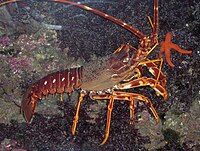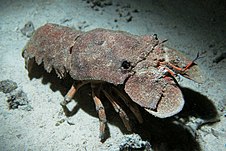아켈라타
Achelata| 아켈라타 시간 범위: | |
|---|---|
 | |
| 필로소말라바 아켈라타의 특징입니다. (Haeckel 그림) | |
| 과학적 분류 | |
| 왕국: | 애니멀리아 |
| 문: | 절지동물 |
| 하위문: | 갑각류 |
| 클래스: | 말라코스트라카 |
| 주문: | 데카포다 |
| 서브오더: | 슬개골목 |
| (순위 미지정): | 파충류 |
| 인프라스트럭처: | 아켈라타 숄츠 & 리히터, 1995년 |
| 패밀리 | |
아켈라타는 갑각류의 하위 목으로 가시가 많은 바닷가재, 슬리퍼 바닷가재, 그리고 그들의 화석 동족을 포함하고 있다.
묘사
"아켈라타"라는 이름은 이 그룹의 모든 구성원들이 거의 모든 다른 십각류에서 발견되는 킬레(chelae)가 부족하다는 사실에서 유래했다.그들은 두 번째 더듬이의 거대한 확대, 애벌레의 특별한 "필로소마" 형태, 그리고 많은 다른 [2]특징들에 의해 더욱 결합됩니다.
분류 및 화석 기록
아켈라타목은 걷는/기어다니는 십각류(랍스터와 게)로 구성된 렙탄티아목에 속합니다.아래 분해도(cradogram)는 Wolfe et al.,[3] 2019의 분석에서 더 큰 차수의 데카포다에 있는 Archelata의 위치를 보여준다.
| 데카포다 |
| ||||||||||||||||||||||||||||||||||||||||||||||||||||||||||||
아켈라타는 가시가 많은 바닷가재(Palinuridae), 슬리퍼 바닷가재(Sylaridae), 털가재(Synaxidae, 현재 보통 Palinuridae에 [4]포함)와 함께 멸종된 두 과인 Cancrinidae와 [1]Tricarinidae를 포함하고 있습니다.
Palinuridae와 Scylaridae 둘 [5][6]다 백악기로 거슬러 올라가는 화석 기록을 가지고 있다.두 개의 화석 과는 [1]각각 하나의 속(속)을 포함하고 있다; 트리카리나는 백악기 화석 [7]한 개로 알려져 있고, 칸크리노는 쥐라기와 [6]백악기로 알려져 있다.아켈라타와 가장 가까운 친척들 사이의 격차에 대한 한 추정치에 따르면 아켈라타는 약 3억 4천 1백만 년 [8]전으로 추정됩니다.
레퍼런스
- ^ a b c Sammy De Grave; N. Dean Pentcheff; Shane T. Ahyong; et al. (2009). "A classification of living and fossil genera of decapod crustaceans" (PDF). Raffles Bulletin of Zoology. Suppl. 21: 1–109. Archived from the original (PDF) on 2011-06-06.
- ^ Gerhard Scholtz; Stefan Richter (1995). "Phylogenetic systematics of the reptantian Decapoda (Crustacea, Malacostraca)" (PDF). Zoological Journal of the Linnean Society. 113 (3): 289–328. doi:10.1006/zjls.1995.0011.
- ^ Wolfe, Joanna M.; Breinholt, Jesse W.; Crandall, Keith A.; Lemmon, Alan R.; Lemmon, Emily Moriarty; Timm, Laura E.; Siddall, Mark E.; Bracken-Grissom, Heather D. (24 April 2019). "A phylogenomic framework, evolutionary timeline and genomic resources for comparative studies of decapod crustaceans". Proceedings of the Royal Society B. 286 (1901). doi:10.1098/rspb.2019.0079. PMC 6501934. PMID 31014217.
- ^ Ferran Palero; Keith A. Crandall; Pere Abelló; Enrique Macpherson; Marta Pascual (2009). "Phylogenetic relationships between spiny, slipper and coral lobsters (Crustacea, Decapoda, Achelata)". Molecular Phylogenetics and Evolution. 50 (1): 152–162. doi:10.1016/j.ympev.2008.10.003. PMID 18957325.
- ^ Francisco J. Vega; Pedro García-Barrera; María del Carmen Perrilliat; Marco A. Coutiño; Ricardo Mariño-Pérez (2006). "El Espinal, a new plattenkalk facies locality from the Lower Cretaceous Sierra Madre Formation, Chiapas, southeastern Mexico" (PDF). Revista Mexicana de Ciencias Geológicas. 23 (3): 323–333.
- ^ a b Joachim T. Haug; Carolin Haug; Dieter Waloszek; Andreas Maas; Matthias Wulf; Günter Schweigert (2009). "Development in Mesozoic scyllarids and implications for the evolution of Achelata (Reptantia, Decapoda, Crustacea)" (PDF). Palaeodiversity. 2: 97–110.
- ^ Rodney M. Feldmann; Ali Kolahdouz; Bijan Biranvand; Guenter Schweigert (2007). "A new family, genus, and species of lobster (Decapoda: Achelata) from the Gadvan Formation (Early Cretaceous) of Iran" (PDF). Journal of Paleontology. 81 (2): 405–407. doi:10.1666/0022-3360(2007)81[405:ANFGAS]2.0.CO;2. Archived from the original (PDF) on 2016-03-04. Retrieved 2012-02-05.
- ^ Keith A. Crandall; Megan L. Porter; Marcos Pérez-Losada (2009). "Crabs, shrimps and lobsters (Decapoda)". In S. Blair Hedges; Sudhir Kumar (eds.). The Timetree of Life. Oxford University Press. pp. 293–297. ISBN 978-0-19-160898-8.
외부 링크
 Wikimedia Commons의 Achelata 관련 미디어
Wikimedia Commons의 Achelata 관련 미디어






